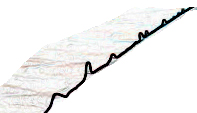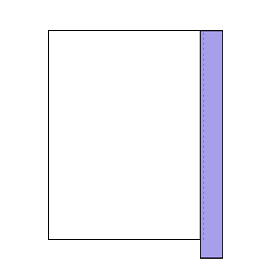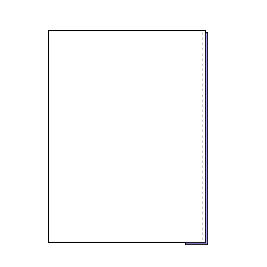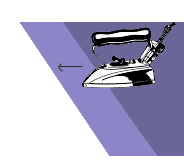| What is a Wavy Border (and why should I care)? |
If you lay your quilt flat on the floor and the center of the quilt is nice and flat but the borders seem to have a wave to them, whether big or small, this is going to pose problems when you have it longarmed. A very small wave can often be steamed (shrunk) but what often happens is that a tuck or pleat will appear in your border (which you don't want).

This most likely occurred because when sewing on your borders, you took a border strip of fabric that was longer than your quilt edge and started at one end and sewed it on. Like this:

Sure, this is the easiest and quickest way to do the border, but the reason this is not good is pure physics.
Since we all know that quilting is not as precise as we'd like it to be and usually measurements vary along the length and width of the quilt, you are essentially allowing that tiny strip of fabric to continue (and magnify) any variances in measurements. For example, measure your quilt in three places -- is the measurement exactly the same? Probably not -- you might have 84.25" in one place, 84.5" in another, and maybe even a whopping 85" in another. Even the most exacting quilter can find this. I received one quilt that was 4 inches longer on the right side than the left!
| Solution: |
If you've done your border as above, sorry, but you'll need to remove your borders and follow the steps for Prevention.
| Prevention: |
1. Measure your quilt in the center one of the directions (width or length).
(Why the center? -- its most likely to be the squarest measurement.).
Mark the center with a pin.

2. Using the measurement, cut the border strip to exactly that number. For example, say you chose to use your length and it was 56.75". Cut two border strips (or piece together if it is longer than your fabric) to be EXACTLY that measurement to use for your long borders.
3. Fold your first border in half and mark that center with a pin. Match your center pin on the border strip with the center pin on your quilt. Now pin both ends of the border to match exactly with the edges. (Yes... PIN!, no cheating here and trying to just go back to sewing the strip).

4. Continue pinning as needed along the length of the border strip, easing in any waves/fullness. Expect there to be some -- especially if you are fixing a wavy border, there was fullness to start with that you need to ease in.
5. Sew with the quilt on top, border on the bottom.
(Why? Because this allows the feed dogs to help you ease in that fullness). Be careful not to catch in and pleat any of the fullness as you go along.
6. Press.
HINT: As we mention in our preparation page, iron side to side (from inner part of the quilt to outer edge), not lengthwise along the border). This will help avoid stretching the fabric and adding waviness back in.
7. Repeat the sewing/pressing process for the other long border.
8. Now go back and measure your other direction (width in the case of our example). Measure the EXACT width including the border piece you just did. Go back to step three and complete your last two borders.
Question: What do you do if you get a quilt to longarm that has wavy borders? |
- If its something I notice during our consultation, I will suggest you take the quilt back and fix it as above.
- Most of the time, the waviness isn't apparent until I'm
halfway through the quilting process (or sometimes all the way to the
bottom if the problem is only with the bottom border) . In this case:
- If not too bad, I will try to steam/shrink it in or ease while I'm doing the quilting so that any puckers or fullness are not as noticeable.
- If really bad, and if possible, I will take out a border seam while the quilt is still on the frame and make the seam take in the fullness. If that's not possible, I sometimes can make a "fake" seam where the fullness occurs. In both of these cases, I need to hand sew the new seam line down. NOTE: This will definitely incur a separate charge to your quilting -- anywhere from $10.00 and up depending on how long it takes me.
- And if neither of those work, you'll end up with puckers
in the border, which I will feel really bad about, but there won't have
been anything I could do about it.

